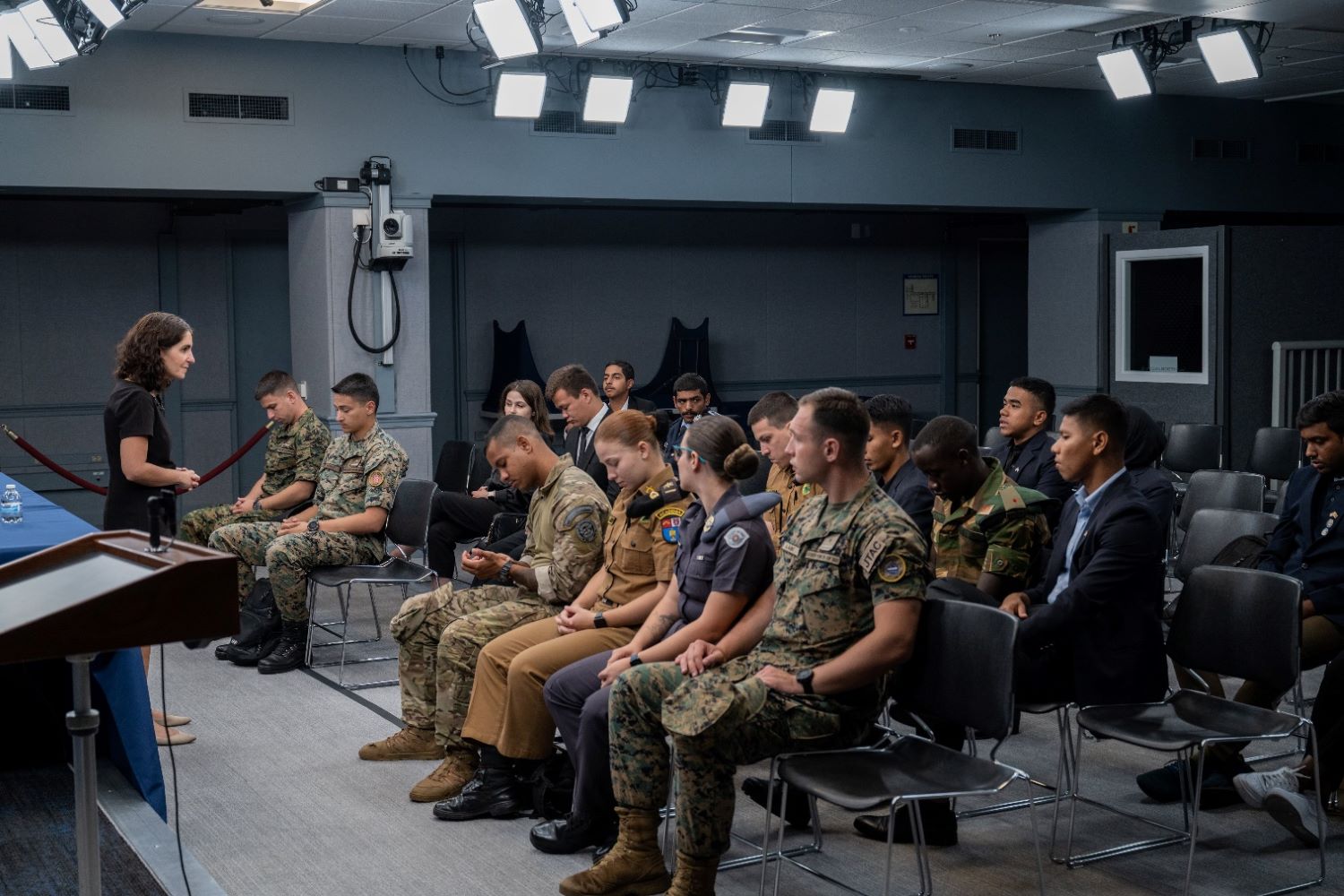Navigate the ‘Deep Sea’ of Federal Business with Richard Howard’s Story

In a world where national security and technological advancement are paramount, securing a lucrative government defense contract isn’t just a business achievement; it’s a demonstration of capabilities that can shape the future.
The prospect of winning a defense contract worth eight figures might seem like a daunting task, but with careful planning, strategic execution, and an in-depth understanding of the complex defense procurement landscape, it’s an attainable goal.
The path to winning substantial defense contracts is riddled with challenges and opportunities that require a nuanced approach. From deciphering intricate government procedures to forging crucial relationships with key decision-makers, this journey demands an astute understanding of the multifaceted acquisition process.
Richard Howard: Traversing Military Skies to Commanding Contracts
Richard Howard’s impact and knowledge span extensively across the domain of government contracts. With an impressive track record, he supervises DoD contracts exceeding $82 billion, showcasing his expertise in maneuvering the complex landscape of defense acquisitions.
Moreover, he has established himself as a prominent advisor, offering guidance and instruction to over 320 companies. As the President of Richard C. Howard & Associates and the innovative mind behind the inception of DoD Contract Academy, he offers essential direction, training, and support to small business proprietors and sales leaders grappling with the intricate path of defense sales procedures.
But before delving into his impactful role in the sphere of government contracts, it’s crucial to note Richard Howard’s rich military background and his subsequent transition to a new position.
“I spent 20 years in the Air Force and the first half of that was flying and I got some flying memorabilia, behind me I flew intelligent surveillance and reconnaissance aircraft. So, 9/11 kicked off when I first came in so that was, I mean that’s pretty much deployed for that first 10 years, flying missions.” – he said.
Howard’s pivotal role during the aftermath of the 9/11 tragedy attests to his dedication to duty. In a period defined by uncertainty and the need for swift responses, he played an instrumental part in missions that provided critical intelligence. His service during this period underscores his willingness to rise to the occasion, even when faced with the most challenging and consequential circumstances.
Howard’s professional journey is really a testament to his commitment to service and leadership.
His experiences are further underscored by his positions as Branch Chief and Chief of Materiel Solutions Analysis (MSA) at Hanscom Air Force Base, where he honed his skills in analytical thinking and solutions-driven approaches.
His tenure as Wing Executive Officer at Warner Robins Air Force Base in Georgia added a layer of understanding in executive leadership. Notably, his time as a Combat Systems Officer in various global locations, from Texas to Saudi Arabia, shaped his tactical expertise and cultural adaptability.
As he advanced in his military journey, he underwent a notable transition. This transition marked a shift from the cockpit to the procurement process—an area often characterized by its intricate regulations and strategic decision-making.
In 2019, he assumed the role of President at Richard C. Howard & Associates, MA, where he continues to lead and make significant contributions to the field of government contracts and acquisitions.
“As a former USAF acquisitions officer my job was to put companies on contract for the government that could solve our problems. From needed services such as accounting, landscaping and program management to developing high end technological solutions with startups I got to see first-hand what it takes to consistently go on contract with the government.” – he stated.
Unveiling Insights from Master Navigator Richard Howard!

One of the key insights Howard shares is the fact that a vast majority of individuals within the government—approximately 99.9 percent—lack the authority to make purchasing decisions.
“But especially in the military, we have an Acquisitions career Force. So, we have Contracting officers, which have warrants and they are the ones that can legally put you on contract and then we have program teams, program managers, and they are the leaders of the Acquisitions effort.” – he said.
In the pursuit of defense contracts, Howard emphasizes the diversity of industries that can be involved. From small businesses offering cybersecurity solutions to more substantial endeavors like satellite technology or weapon systems, each venture requires a cohesive team and a dedicated program manager to navigate the acquisition process.
Howard’s commitment to aiding smaller enterprises is evident in his post-retirement endeavors. Recognizing that the government’s procurement process extends beyond traditional notions of weaponry, he aims to empower businesses by demystifying the acquisition process and guiding them toward success in securing contracts.
One of the unique aspects of government procurement is its transparency. Howard notes that federal spending is a matter of public knowledge. Although certain specifics might remain classified, a substantial segment of government acquisitions—comprising even those within classified domains—are well-documented and reachable via diverse online sources.
Transparency in government procurement is an indispensable pillar of accountable governance. This practice involves making the entire procurement process accessible to the public, ensuring that every step, from soliciting bids to awarding contracts, is visible and comprehensible. By doing so, governments foster accountability, preventing the veils of secrecy that can shroud misuse of public funds. Transparent procurement processes also stand as bulwarks against corruption, as they minimize opportunities for under-the-table dealings.
This openness facilitates fair competition by enabling all eligible vendors and contractors to equally access information about procurement opportunities. It establishes a level playing field where merit and quality take precedence over favoritism. Moreover, public trust is nurtured when citizens witness their governments engaging in procurement with integrity and prudence.
Howard underscores the importance of grasping how the government approaches purchases relevant to your product or service. His approach centers on illuminating the intricacies of this distinct procurement process, which often leaves companies bewildered upon initial engagement. Despite a myriad of solicitations and opportunities, the misconception that simply responding to proposals will yield success can lead to unmet expectations.
The challenge is the potential for either making assumptions about the process or becoming overwhelmed by its complexity. Howard’s efforts, echoed in platforms like YouTube and podcasts, focus on demystifying this process. His objective involves simplifying the intricate terrain, offering well-defined procedures and anticipated outcomes. This empowers companies to not only navigate but also flourish in the domain of government contracts.
Aligning with Government Needs: The Foundation of Success
Through Richard Howard’s counsel, the complexities of maneuvering the government procurement expanse are unfurled, revealing crucial phases that shine as a guiding light for enterprises striving to master this intricate domain.
At its core lies a fundamental question: Does your product, solution, or service align with the government’s needs? This initial inquiry serves as the foundation upon which the journey is embarked.
In the complex world of government procurement, where rules, regulations, and a multitude of stakeholders converge, this fundamental alignment holds paramount importance. It is the starting point that determines whether your offering has the potential to address the unique challenges, requirements, and objectives of the government agency.
This alignment assessment demands a deep dive into understanding the intricacies of the government’s operational landscape. What are their goals, priorities, and constraints? How does your offering seamlessly integrate into their existing systems and processes? How can it enhance their efficiency, effectiveness, and service delivery to the citizens they serve?
As this alignment is established, the foundation is laid for a journey that involves strategic communication, meticulous planning, and diligent execution. It’s not merely about showcasing what your product, solution, or service can do; it’s about showcasing what it can do for the government’s specific needs.

Howard’s insights illuminate a compelling reality: in a substantial number of instances, the government presents itself as a potential purchaser. To truly grasp the magnitude of this potential, he emphasizes the importance of fully understanding the government’s annual expenditures within your area of expertise. This strategic maneuver strategically positions your business, allowing it to harmonize seamlessly with the context of government spending trends.
The path forward demands meticulous focus. Howard ardently suggests channeling your efforts toward one or two government agencies that align closely with your domain knowledge. By concentrating your attention on specific entities, you unlock the door to a comprehensive exploration of their unique procurement procedures.
Whether it’s navigating GSA (General Services Administration) contracts, engaging in competitive bid processes, navigating sole-source arrangements, or strategically participating in specialized set-asides, a profound comprehension of their preferred mechanisms becomes pivotal in charting your successful trajectory.
Having established compatibility and finely tuned your focus, the pursuit of identifying opportunities comes into play. In this endeavor, Howard champions the proactive monitoring of government solicitations, which act as windows into forthcoming projects and contracts.
Market Research: The Vital Phase in Government Contracting
The above phase is firmly rooted in understanding the preliminary market research conducted by government agencies. It’s during this phase that vendor evaluation takes shape and requirements are defined, providing your business with invaluable insights to strategically align your offerings.
Richard Howard’s words resonate powerfully: “It’s the most important phase for any company selling to the government.
For Howard, the significance of the market research phase cannot be overstated. Drawing from his own experiences, he notes, “I have one client – we sell their software licenses – and I’m solidly in that market research phase. That’s where we kick butt and take names.”
This phase serves as the cornerstone for businesses seeking to enter the government contracting arena, enabling them to position themselves strategically and understand the landscape they are navigating.
As Howard elucidates, the market research phase is the juncture where companies gain a deep understanding of government needs, preferences, and trends. It involves delving into available data, analyzing past contracts, and identifying patterns in procurement. This informed approach allows businesses to tailor their offerings to align precisely with government requirements.
However, as crucial as market research is, it’s important to recognize the changing dynamics once a solicitation is released. Howard notes, “When the solicitation comes out, the handcuffs are on.” At this stage, government acquisitions teams are bound by strict regulations to avoid showing any preferential treatment to any business. This level playing field ensures that all businesses have an equal opportunity to compete based on their capabilities and merits.
Cultivating Trust through Reliability: Perspective on Relationship-Building
Amidst this dynamic landscape, the art of relationship-building takes center stage. Engaging with program offices not only provides deeper insights into their requirements but also affords you the chance to showcase your dependability.
Howard’s guidance underscores the profound significance of reliability—consistently meeting commitments, demonstrating punctuality, and displaying responsiveness—all of which significantly influence how your business is perceived during the evaluation phase. These attributes often shape the impression that potential clients, in this case, government agencies, hold of your business’s competence and professionalism.

Reliability isn’t just a buzzword—it’s a cornerstone that comprises consistent commitment fulfillment, unwavering punctuality, and steadfast responsiveness. These qualities exercise a transformative influence, substantially shaping how your business is perceived during the critical evaluation phase. They extend their influence even further, shaping the impression that potential clients, particularly government agencies, develop regarding your business’s overall competence and professionalism.
Howard’s wisdom encapsulates this aspect: “If you’re trying to push a deal through, you’re working with that program office over a period of time. They’re getting to know you. Even if it’s during the bidding process, our five processes, you’re having meetings with them. They’re going to discern your reliability, whether you fulfill your promises. Even the seemingly simple actions, such as arriving promptly for meetings or delivering requested documents, resonate.”
Besides, establishing your digital presence as a reliable, credible, and responsive entity magnifies the impression you leave. Your website, social media platforms, and online interactions collectively convey your business’s commitment to promises. This amplifies your standing not only during the evaluation phase but throughout the journey.
Following instructions – Do Not Piss Anyone Off
If they say 12-point font Ariel or Times New Roman, do not use anything else other than that. If they say, “no phone call”, so don’t call them, if they say, “I’m open the market research”, then submit for market research.
As the doors swing open to market research, seize the moment. The invitation isn’t a mere formality—it’s a pivotal juncture to contribute insights, harmonize with requisites, and actively shape solutions. This juncture shouldn’t be passed by; it’s an avenue to showcase your offerings aligned with strategic precision.
Nonetheless, wisdom imparts a caveat, echoing through Howard’s words: attention to detail is of paramount importance. In solicitations where exclusivity is the norm, like those within the esteemed 1%, each page carries significance. The importance of this detail goes beyond a mere adherence to guidelines—it’s a recognition of those critical moments where adherence holds the key to successful navigation.
In Howard’s words, “the only caveat that I would put on that is, for solicitations like you are a million and one percent, it’s like you can’t have a page count. If you put an extra page in there, that page is getting thrown in the trash.”
Expanding Your Toolkit: Insights into Crucial Parallel Aspects
Richard Howard’s counsel underscores a valuable truth: they’re not pondering your next sale or your quarterly business review (QBR). Their focus is steadfastly fixed on the mission—whether military or the next governmental imperative. But therein lies an opportunity.
His words resonate: “If it’s the military, what the next thing is on their plate on the government side, but if you ask them, they’ll start thinking, they’ll pause to think about it, especially if they like you and they think you do good work, they’re going to help you out. There’s a lot of work to be gained when you’re contracted with the government just by talking to people and having those conversations.”
The premise is clear—initiate conversations that transcend transactions. Engage with a genuine curiosity about their mission, challenges, and future undertakings. Their inclination to help you stems from the appreciation of your sincerity and the quality of your work. These conversations extend beyond the immediate, leading to a wealth of opportunities hidden within the dialogue.

In addition, certifications emerge as tangible symbols of expertise, carrying significant weight in the eyes of government agencies. Richard Howard’s advice emphasizes the transformative impact of these credentials.
Certifications transcend mere symbols; they are markers that communicate to decision-makers that you possess not only the necessary knowledge but also the capabilities to meet their rigorous requirements. They signify your commitment to industry standards, catapulting you into the competitive realm of government contracting as a formidable contender.
Within the domain of trust and credibility, there exists an unparalleled sway carried by recommendations. In a milieu where trust constructs the core edifice, commendations originating from contented clientele reverberate akin to affirmations of your dependability and the quality of your provisions.
The weight these testimonials carry is substantial, shaping the perceptions of government decision-makers. Their resonance can significantly influence assessments of your competence and suitability for critical projects, making recommendations a potent asset in your arsenal.
Navigating Strategic Resource Utilization for Informed Decision-Making
Strategic resource utilization is a pivotal cornerstone in this journey. Howard’s guidance highlights the value of leveraging free resources, with a notable mention of USAspending.gov.
“I would go to USAspending.gov to start out because that’s a free website that walks through how the government is spending. And you can start taking a look by the year. You can look by keyword so you can start, and you can go by the NAICS code. So, there are a lot of different criteria, which is a North American Industry Classification System code, but it will help you out. You can start typing in whatever it is you specialize in—accounting, for instance—and it’s going to pull it up.” – He said.
Besides, he also mentioned other resources: “There are a lot of free resources that you can check out, whether it’s Kizzy channel or the podcast, and certainly there are paid resources.”
“You can also look at the agencies, it’s also list them out in order… it gives you a start” – he added.
Moreover, when seeking insights into government spending and financial data, a range of other valuable resources are available. The Federal Procurement Data System (FPDS) serves as an authoritative source for data related to federal procurement, contracts, and grants.
Data.gov offers an expansive repository of government datasets spanning diverse sectors, providing a wealth of information for analysis. OpenGov equips governments with tools to manage financials and performance metrics, and some jurisdictions make such data accessible to the public.
Additionally, the Federal Audit Clearinghouse offers access to audit reports, the Federal Reserve Economic Data (FRED) presents economic indicators, and the Government Accountability Office (GAO) issues reports on spending and accountability. Further insights can be obtained from the SEC EDGAR Database, Census Bureau Economic Indicators, Treasury Department’s Financial Management Service (FMS), and local government websites, collectively enriching the understanding of government financial activities.
These repositories offer a panoramic view of government spending trends—an abundance of insights for informed decision-making. Its intuitive search functionalities empower you to tailor your exploration, diving deep into domains of specific interest.
This strategic utilization of data-rich resources allows you to navigate the complexities of government expenditures, enabling decisions that seamlessly align with the evolving patterns of need.
However, amid this quest for knowledge, a crucial caveat emerges, accuracy and reliability. The pursuit of information must be guided by trustworthiness and grounded in credible sources. Howard’s advice underscores the significance of extracting insights from government-specific platforms—reliable sources of data integrity. This fidelity to authoritative sources ensures that your strategic decisions are built upon the foundations of currency and relevance.








